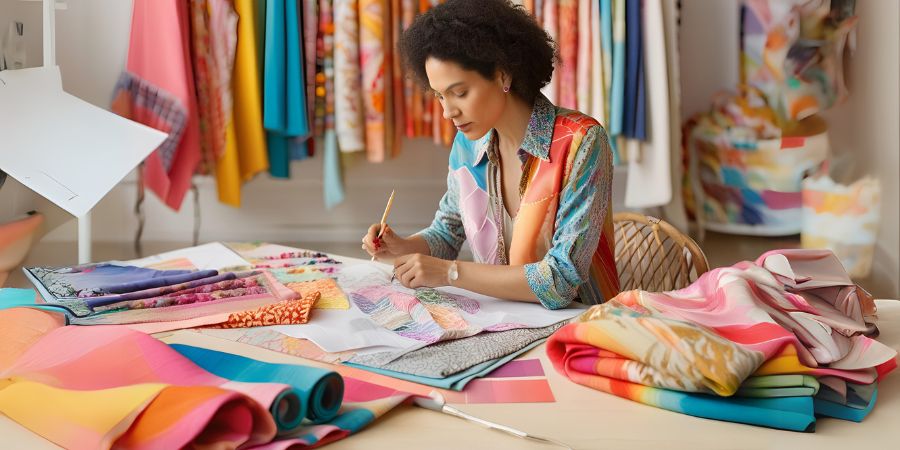Fashion design is a blend of creativity, artistry, and technical skills, requiring a deep understanding of trends, materials, and personal style. Whether you’re an aspiring designer or a hobbyist, understanding the essential steps and principles involved can help you bring your fashion ideas to life. This guide will walk you through the process of designing fashion clothes, from initial inspiration to final creation.
Understanding the Basics of Fashion Design
What is Fashion Design?
Fashion design is the art of applying design, aesthetics, and functionality to clothing and accessories. It involves creating garments that are not only visually appealing but also practical and comfortable for the intended audience.
The Role of a Fashion Designer
Fashion designers are responsible for:
- Researching trends and forecasting future styles.
- Sketching original designs and creating prototypes.
- Selecting fabrics, colors, and patterns.
- Overseeing production to ensure the final product aligns with their vision.
Skills Required in Fashion Design
Before diving into the design process, it’s essential to develop the following skills:
- Sketching and Illustration: The ability to translate ideas onto paper.
- Fabric Knowledge: Understanding different materials and how they behave.
- Sewing and Draping: Technical skills to create prototypes.
- Trend Analysis: Staying updated on fashion industry movements.
- Attention to Detail: Ensuring precision in design and construction.
The Step-by-Step Process of Designing Fashion Clothes
1. Find Your Inspiration
Inspiration is the foundation of any creative process. Designers often draw inspiration from:
- Nature: Patterns, colors, and textures found in flora and fauna.
- Art and Architecture: Historical or modern art pieces and structures.
- Culture: Traditions, festivals, and cultural symbols.
- Personal Experiences: Memories, emotions, and unique perspectives.
How to Collect Inspiration
- Maintain a sketchbook for rough sketches and notes.
- Create mood boards using magazine clippings, photographs, and fabric samples.
- Explore online platforms like Pinterest and Instagram for trend insights.
2. Research Current Trends
Understanding market demands and upcoming trends is crucial. Research involves:
- Trend Reports: Utilize resources like WGSN or Vogue Runway.
- Social Media Analysis: Observe what’s trending on platforms like TikTok and Instagram.
- Fashion Shows: Watch seasonal shows to study patterns, colors, and themes.
3. Define Your Target Audience
Your designs should align with the preferences and needs of your audience. Consider:
- Demographics: Age, gender, and location.
- Lifestyle: Daily activities and social preferences.
- Fashion Preferences: Casual, formal, avant-garde, or sporty styles.
Example:
If designing for teenagers, focus on bold colors, trendy cuts, and affordable fabrics.
4. Develop a Concept and Theme
A cohesive theme gives your collection a unified identity. For example:
- Concept: “Modern Renaissance” – merging classical elements with contemporary designs.
- Theme: Focus on opulent fabrics, pastel tones, and intricate embroidery.
5. Create Initial Sketches
Using your concept, start sketching rough designs. These should:
- Highlight silhouettes and garment structure.
- Incorporate details like pleats, pockets, or buttons.
- Experiment with layering and fabric placement.
Tips for Sketching:
- Use a croquis (body template) to save time.
- Start with pencil sketches and refine later with color.
- Add notes about fabric choices and embellishments.
6. Choose Fabrics and Materials
The fabric sets the tone for the garment’s look and feel. Key considerations include:
- Texture: Smooth silk vs. rough denim.
- Durability: Suitable for frequent wear or delicate for special occasions.
- Drape: How the fabric falls on the body.
Common Fabrics:
- Cotton for casual wear.
- Satin and velvet for formal attire.
- Jersey for activewear.
7. Make Prototypes
Prototypes or samples help visualize the design in real life. This step involves:
- Creating a muslin version of the garment.
- Testing the fit and making adjustments.
- Identifying potential construction challenges.
Prototyping Tools:
- Sewing machine
- Pins and needles
- Pattern paper
8. Finalize the Design
Refine your sketches and prototypes based on feedback. Final designs should:
- Be technically accurate with detailed measurements.
- Include notes on fabric types, stitch styles, and embellishments.
9. Prepare for Production
If creating a collection for commercial purposes, coordinate with manufacturers. Steps include:
- Pattern Making: Creating technical patterns for mass production.
- Sourcing Materials: Ordering fabrics and trims in bulk.
- Quality Checks: Ensuring consistency in every piece.
Tips for Designing Unique Fashion Clothes
Embrace Sustainability
Modern consumers value ethical and eco-friendly practices. Design with:
- Organic or recycled fabrics.
- Zero-waste patterns.
- Local artisanship to reduce carbon footprints.
Experiment with Technology
Integrate technology into your designs with:
- Smart fabrics (e.g., temperature-regulating materials).
- 3D printing for accessories and intricate details.
- Digital sketches using tools like Adobe Illustrator.
Stay True to Your Aesthetic
While trends are important, maintaining a signature style helps build a unique brand identity. Experiment, but always ensure your designs reflect your artistic vision.
Common Challenges and How to Overcome Them
Lack of Inspiration
- Take breaks and explore other creative fields.
- Visit museums, nature parks, or bustling markets.
Budget Constraints
- Opt for cost-effective fabrics like polyester blends.
- Focus on designing versatile pieces that require minimal fabric.
Skill Gaps
- Enroll in online or offline courses.
- Practice regularly and seek mentorship from experienced designers.
FAQs on Fashion Design
How do I start designing fashion?
Start by building foundational skills such as sketching, sewing, and understanding fabrics. Research current trends and experiment with creating simple designs inspired by your surroundings.
How to make designs of clothes?
To make clothing designs, start with a concept or theme. Sketch your ideas, select suitable fabrics, and create prototypes to refine your designs.
How do fashion designers design clothes?
Fashion designers begin with inspiration and research. They sketch ideas, select materials, create patterns, and develop prototypes before finalizing the designs for production.
How do you create a fashion style?
Creating a fashion style involves understanding your preferences and experimenting with different aesthetics. Study trends but incorporate unique elements that reflect your personality.
How do I find my style?
Find your style by exploring different fashion influences, trying out various outfits, and identifying what makes you feel confident and comfortable.
How do I start a fashion content?
To start fashion content, choose a niche (e.g., styling tips or trend analysis). Use platforms like Instagram or YouTube to share visually engaging content and connect with your audience.
Conclusion
Designing fashion clothes is a rewarding journey that combines artistry with technical expertise. By following the outlined steps, you can transform your creative ideas into tangible garments that resonate with your audience. Remember, every design tells a story—let yours be one that inspires and captivates.


